Shopping mall
A shopping mall (or simply mall) is a North American term for a large indoor shopping center, usually anchored by department stores. The term "mall" originally meant a pedestrian promenade with shops along it (that is, the term was used to refer to the walkway itself which was merely bordered by such shops), but in the late 1960s, it began to be used as a generic term for the large enclosed shopping centers that were becoming commonplace at the time.[1][2] In the U.K., such complexes are considered shopping centers (Commonwealth English: shopping centre), though "shopping center" covers many more sizes and types of centers than the North American "mall". Other countries may follow U.S. usage (India,[3] U.A.E.,[4] etc.) and others (Australia,[5] etc.) follow U.K. usage.
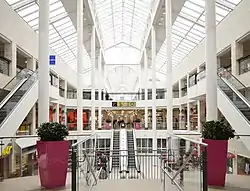
Many malls have declined considerably (especially in the United States and Canada), and some have closed and become so-called "dead malls". Successful exceptions have added entertainment and experiential features, added big-box stores as anchors, or converted to other specialized shopping center formats such as power centers, lifestyle centers, factory outlet centers, and festival marketplaces.[6]
Types of shopping malls
The International Council of Shopping Centers classifies two types of shopping centers as malls: regional malls and superregional malls.
Regional mall
A regional mall is as per the International Council of Shopping Centers, in the United States, a shopping mall with 400,000 sq ft (37,000 m2) to 800,000 sq ft (74,000 m2) gross leasable area with at least two anchor stores.[7]
Superregional mall
A superregional mall is, per the International Council of Shopping Centers, in the US, a shopping mall with over 800,000 sq ft (74,000 m2) of gross leasable area, three or more anchors, mass merchant, more variety, fashion apparel, and serves as the dominant shopping venue for the region (25 miles or 40 km) in which it is located.[7]
Not malls
Not classified as malls are smaller formats such as strip malls and neighborhood shopping centers, and specialized format such as power centers, festival marketplaces, and outlet centers.[6]
On the other hand, in some countries, many shopping centres less than half or a quarter of the size of the U.S. minimum to be considered a mall, 400,000 sq ft (37,000 m2), have "mall" in their names – see List of shopping centres in Namibia or List of shopping centres in Zambia for examples.
The world's largest malls with over 500,000 square metres (5,400,000 sq ft) of gross leasable area are in China, Thailand, The Philippines, more than half again as large as previous contenders such as the Dubai Mall.
List of types of shopping centers (including malls)
The International Council of Shopping Centers classifies Asia-Pacific, European, U.S., and Canadian shopping centers into the following types:[6][8][9][10]
Abbreviations: SC=shopping center/centre, GLA = Gross Leasable Area, NLA = Net Leasable Area, AP=Asia-Pacific, EU=Europe, Can=Canada, US=United States of America
*does not apply to Europe
| Type | USA: GLA in ft2 | USA: GLA in m2 | Europe: GLA in m2 | Canada: GLA in ft2 | Asia-Pacific: NLA in ft2 | # anchors* | Typical anchors |
|---|---|---|---|---|---|---|---|
| Large general-purpose centers (US/AP) / traditional shopping centres (EU/Can) | |||||||
| Mega-mall (AP) | n/a | n/a | n/a | n/a | 1,500,000+ | 3+ | Department stores, supermarkets, hypermarkets, multicinemas, major entertainment/leisure |
| Super-regional mall/center EU: Very large SC |
800,000+ | 74,322+ | 80,000+ | 800,000+ | 800,000–1,499,999 | 3+ | Regular/discount department stores, in Europe and Asia also supermarkets, hypermarkets, cinemas, major entertainment/leisure |
| Regional mall/center EU: Large SC |
400,000–800,000 | 37,161–74,322 | 40,000–79,999 | 300,000–799,999 | 500,000–799,999 | 2+ | |
| Small & medium general-purpose centers (US/AP) / traditional shopping centres (EU/Can) | |||||||
| Sub-regional SC (AP) Europe: Medium SC |
n/a | n/a | 20,000–39,999 | n/a | 200,000–500,000 | 0–3 | Supermarket, hypermarket, small/discount department stores |
| Small comparison-based SC (EU) | n/a | n/a | 5,000–19,999 | n/a | n/a | n/a | Apparel, home furnishing, electronics, gifts, etc. |
| Small convenience-based SC (EU) | n/a | n/a | 5,000–19,999 | n/a | n/a | n/a | Supermarket, hypermarket, pharmacy, convenience store, household goods, etc. |
| Community shopping center | 125,000–400,000 | 11,613–37,161 | n/a | 100,000–400,000 | n/a | 2+ | Discount store, supermarket, drugstore, category killer. a.k.a. large neighborhood shopping center in US, Canada |
| Neighborhood shopping center | 30,000–125,000 | 2,787–11,613 | n/a | 40,000–99,000 | 20,000–200,000 | 1+ (US/Can) 0–2 (AP) |
Supermarket, in Asia also hypermarket |
| Convenience center US/Can also "Strip mall" |
<30,000 | <2,787 | n/a | 10,000–39,000 | n/a | 0–1 | Convenience store anchor or anchorless |
| Specialized shopping centers | |||||||
| Power center EU: a.k.a. "Retail park" |
250,000–600,000 | 23,226–55,741 | S:5,000+ M:10,000+ L:20,000+ |
100,000–1,000,000 | >50,000 | 3+ (US/Can) n/a (AP) |
Category killers, warehouse clubs, large discount stores. In Asia 90% of NLA must be these. |
| Lifestyle center (US) | 150,000–500,000 | 13,935–46,452 | n/a | n/a | n/a | 0–2 | Large-format upscale specialty stores |
| Outlet mall/center | 50,000–400,000 | 4,645–37,161 | 5,000 | 50,000–400,000 | "no max. size" | n/a | Manufacturers' and retail outlet stores |
| Theme/Festival (US) (Festival marketplace) |
80,000–250,000 | 7,432–23,226 | n/a | n/a | n/a | n/a | Restaurants, specialty stores catering to visitors, entertainment |
| Leisure/entertainment centre (AP) Leisure-based SC (EU) |
n/a | n/a | 5,000 | n/a | <500,000 | N/A | Entertainment and/or F&B (food and beverage) (in Asia, 50%+ of tenants are these), plus specialty stores catering to visitors, fast fashion, electronics, sports. Europe: usually anchored by a multiplex cinema and also may include bowling, fitness. Excludes centers at transport hubs. |
| Specialty SC (AP) | n/a | n/a | n/a | n/a | <500,000 | 0 | Specialty shops with general product mix (apparel, F&B, electronics, etc.) |
| Single category SC (AP) Non-leisure-based themed SC (EU) |
n/a | n/a | 5,000+ | n/a | n/a | n/a | Dedicated to single product type other than F&B, groceries or fashion, e.g. information technology, homewares/furniture. In Asia, 80% of NLA should be dedicated to the theme. |
| Major transportation hub SC (AP) | n/a | n/a | n/a | n/a | >50,000 | n/a | Retail at public transportation hubs including airside airport retail |
| Limited-purpose property | |||||||
| Airport retail | 75,000–300,000 | 6,968–27,871 | n/a | n/a | 0 | Speciality retail and restaurants | |
| Shopping centre hybrids (Canada only) | |||||||
| Hybrid SC (Can) | n/a | n/a | 250,000+ | n/a | varies | Has characteristics of two or more shopping center types e.g. power center + regional mall | |
History
Forerunners to the American mall
Shopping centers in general, may have their origins in public markets and, in the Middle East, covered bazaars. In 1798 the first covered shopping passage was built in Paris, the Passage du Caire .[11] The Arcade in Providence, Rhode Island was the first shopping arcade in the United States in 1828.[12]
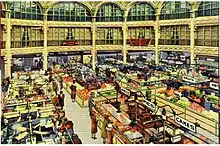
In the mid-20th century, with the rise of the suburb and automobile culture in the United States, a new style of shopping center was created away from downtowns.[13] Early shopping centers designed for the automobile include Market Square, Lake Forest, Illinois (1916), and Country Club Plaza, Kansas City, Missouri (1924).[14]
The suburban shopping center concept evolved further in the United States after World War II (see table above) with larger open-air shopping centers anchored by major department stores, such as the 550,000-square-foot (51,000 m2) Broadway-Crenshaw Center in Los Angeles built in 1947, anchored by a five-story Broadway and a May Company California.[15]
Downtown pedestrian malls and use of term mall
In the late 1950s and into the 1960s, the term "shopping mall" was first used, but in the original sense of the word "mall", that is, a pedestrian promenade (in U.K. usage a "shopping precinct"). Early downtown pedestrianized malls included the Kalamazoo Mall (the first, in 1959), "Shoppers' See-Way" in Toledo, Lincoln Road Mall in Miami Beach, Santa Monica Mall (1965).[16][17][18] Although Bergen Mall (opened 1957) led other suburban shopping centers in using "mall" in their names, these types of properties were still referred to as "shopping centers" until the late 1960s, when the term "shopping mall" started to be used generically for large suburban shopping centers.[19]
Enclosed malls in the U.S.
The enclosed shopping center, which would eventually be known as the shopping mall, did not appear until the mid-1950s. One of the earliest examples was the Valley Fair Shopping Center in Appleton, Wisconsin,[20] which opened in March 1955. Valley Fair featured a number of modern features including central heating and cooling, a large outdoor parking area, semi-detached anchor stores, and restaurants. Later that year the world's first fully enclosed shopping mall was opened in Luleå, in northern Sweden (architect: Ralph Erskine) and was named Shopping; the region now claims the highest shopping center density in Europe.[21]
The idea of a regionally-sized, fully enclosed shopping complex was pioneered in 1956 by the Austrian-born architect and American immigrant Victor Gruen.[22][23][24] This new generation of regional-size shopping centers began with the Gruen-designed Southdale Center, which opened in the Twin Cities suburb of Edina, Minnesota, United States in October 1956.[23][24] For pioneering the soon-to-be enormously popular mall concept in this form, Gruen has been called the "most influential architect of the twentieth century" by Malcolm Gladwell.[25]
The first retail complex to be promoted as a "mall" was Paramus, New Jersey's Bergen Mall. The center, which opened with an open-air format in 1957, was enclosed in 1973. Aside from Southdale Center, significant early enclosed shopping malls were Harundale Mall (1958) in Glen Burnie, Maryland,[26] Big Town Mall (1959) in Mesquite, Texas, Chris-Town Mall (1961) in Phoenix, Arizona, and Randhurst Center (1962) in Mount Prospect, Illinois.
Other early malls moved retailing away from the dense, commercial downtowns into the largely residential suburbs. This formula (enclosed space with stores attached, away from downtown, and accessible only by automobile) became a popular way to build retail across the world. Gruen himself came to abhor this effect of his new design; he decried the creation of enormous "land wasting seas of parking" and the spread of suburban sprawl.[27][28]
In the United States, developers such as A. Alfred Taubman of Taubman Centers extended the concept further in 1980, with terrazzo tiles at the Mall at Short Hills in New Jersey, indoor fountains, and two levels allowing a shopper to make a circuit of all the stores. Taubman believed carpeting increased friction, slowing down customers, so it was removed. Fading daylight through glass panels was supplemented by gradually increased electric lighting, making it seem like the afternoon was lasting longer, which encouraged shoppers to linger.[29][30]
Decline of shopping malls
_crop.jpg.webp)
In the United States, in the mid-1990s, malls were still being constructed at a rate of 140 a year.[31] But in 2001, a PricewaterhouseCoopers study found that underperforming and vacant malls, known as "greyfield" and "dead mall" estates, were an emerging problem. In 2007, a year before the Great Recession, no new malls were built in America, for the first time in 50 years.[32] City Creek Center Mall in Salt Lake City, which opened in March 2012, was the first to be built since the recession.[14]
In recent years, the number of dead malls increased significantly in the early 21st century because the economic health of malls across the United States has been in decline, as identified by high vacancy rates. From 2006 to 2010, the percentage of malls that are considered to be "dying" by real estate experts (have a vacancy rate of at least 40%), unhealthy (20–40%), or in trouble (10–20%) all increased greatly, and these high vacancy rates only partially decreased from 2010 to 2014.[33] In 2014, nearly 3% of all malls in the United States were considered to be "dying" (40% or higher vacancy rates) and nearly one-fifth of all malls had vacancy rates considered "troubling" (10% or higher). Some real estate experts say the "fundamental problem" is a glut of malls in many parts of the country creating a market that is "extremely over-retailed".[33]
Online shopping has also emerged as a competition to shopping malls. In the United States, online shopping has accounted for an increasing share of total retail sales.[34] In 2013, roughly 200 out of 1,300 malls across the United States were going out of business.[35] To combat this trend, developers have converted malls into other uses including attractions such as parks, movie theaters, gyms, and even fishing lakes.[36] In the United States, the 600,000 square foot Highland Mall will be a campus for Austin Community College.[34] In France, the So Ouest mall outside of Paris was designed to resemble elegant, Louis XV-style apartments and includes 17,000 square metres (180,000 sq ft) of green space.[37] The Australian mall company Westfield launched an online mall (and later a mobile app) with 150 stores, 3,000 brands and over 1 million products.[38]
The COVID-19 pandemic also significantly impacted the retail industry. Government regulations forced mall closures, increased entrance controls, and imposed strict public sanitation requirements.[39]
Shape and size of enclosed malls
World's largest malls

The size of the largest shopping centers and malls at any given time continued to increase throughout the twentieth and into the twenty-first centuries. The Outlets at Bergen Town Center, originally called the Bergen Mall, the oldest enclosed mall in New Jersey, opened in Paramus on November 14, 1957, with Dave Garroway, host of The Today Show, serving as master of ceremonies.[40] The mall, located just outside New York City, was planned in 1955 by Allied Stores to have 100 stores in a 1,500,000 sq ft (140,000 m2) mall with three department store anchors.[41][42] At approximately 2,400,000 sq ft (220,000 m2), the Ala Moana Center in Honolulu, Hawaii was one of the largest malls in the United States when it opened for business in August 1959.
The largest enclosed shopping mall from 1986 to 2004 was the 350,000 m2 (3,800,000 sq ft) West Edmonton Mall in Edmonton, Alberta, Canada.[43] Currently, the largest mall in the world is the New South China Mall in Dongguan, China with a gross floor area of 892,000 m2 (9,600,000 sq ft). The world's second-largest shopping mall is the Golden Resources Mall in Beijing, China with a gross floor area of 680,000 m2 (7,300,000 sq ft). SM Megamall in the Philippines, is the world's third-largest at 542,980 m2 (5,844,600 sq ft) of gross floor area. The fourth largest shopping mall in the world is SM City North EDSA in Quezon City, Philippines with a gross floor area of 504,900 m2 (5,435,000 sq ft) and the fifth largest shopping mall is 1 Utama in Malaysia at 465,000 m2 (5,010,000 sq ft) of gross floor area.
The most visited shopping mall in the world and third-largest mall in the United States is the Mall of America, located near the Twin Cities in Bloomington, Minnesota. However, several Asian malls are advertised as having more visitors, including Mal Taman Anggrek, Kelapa Gading Mall and Pluit Village, all in Jakarta, Indonesia; Berjaya Times Square in Malaysia; SM City North EDSA, SM Mall of Asia and SM Megamall, all in Metro Manila, Philippines. The largest mall in South Asia is Lucky One Mall in Karachi, Pakistan.
The Philippines has the most number of shopping malls in the top 100 largest shopping malls in the world with 22.
Vertical malls

High land prices in populous cities have led to the concept of the "vertical mall," in which space allocated to retail is configured over a number of stories accessible by elevators and/or escalators (usually both) linking the different levels of the mall. The challenge of this type of mall is to overcome the natural tendency of shoppers to move horizontally and encourage shoppers to move upwards and downwards.[44] The concept of a vertical mall was originally conceived in the late 1960s by the Mafco Company, former shopping center development division of Marshall Field & Co. The Water Tower Place skyscraper, Chicago, Illinois, was built in 1975 by Urban Retail Properties. It contains a hotel, luxury condominiums, and office space and sits atop a block-long base containing an eight-level atrium-style retail mall that fronts on the Magnificent Mile.
Vertical malls are common in densely populated conurbations such as Hong Kong, Jakarta, and Bangkok. Times Square in Hong Kong is a principal example.[44]
A vertical mall may also be built where the geography prevents building outward or there are other restrictions on construction, such as historical buildings or significant archeology. The Darwin Shopping Centre and associated malls in Shrewsbury, UK, are built on the side of a steep hill, around the former town walls;[45] consequently the shopping center is split over seven floors vertically – two locations horizontally – connected by elevators, escalators and bridge walkways. Some establishments incorporate such designs into their layout, such as Shrewsbury's former McDonald's, split into four stories with multiple mezzanines which featured medieval castle vaults – complete with arrowslits – in the basement dining rooms.
Components
Food court
A common feature of shopping malls is a food court: this typically consists of a number of fast food vendors of various types, surrounding a shared seating area.
Department stores
When the shopping mall format was developed by Victor Gruen in the mid-1950s, signing larger department stores was necessary for the financial stability of the projects, and to draw retail traffic that would result in visits to the smaller stores in the mall as well. These larger stores are termed anchor store or draw tenant. In physical configuration, anchor stores are normally located as far from each other as possible to maximize the amount of traffic from one anchor to another.
Regional differences


"Mall" versus "shopping center/centre"
Shopping mall is a term used predominantly in North America and some other countries that follow U.S. usage (India,[3] U.A.E.,[46] etc.) and others (Australia,[5] etc.) follow U.K. usage.
In North America, Persian Gulf countries, and India, the term shopping mall is usually applied to enclosed retail structures (and is generally abbreviated to simply mall), while shopping center/centre usually refers to open-air retail complexes; both types of facilities usually have large parking lots, face major traffic arterials, and have few pedestrian connections to surrounding neighbourhoods.[47] Outside of North America, "shopping precinct" and "shopping arcade" are also used. In Canada, "shopping centre" is often used officially (as in Square One Shopping Centre), but conversationally, "mall" is mostly used.
Europe
There are a reported 222 malls in Europe. In 2014, these malls had combined sales of US$12.47 billion.[48] This represented a 10% bump in revenues from the prior year.[48]
U.K. and Ireland
In the United Kingdom and Ireland, both open-air and enclosed centers are commonly referred to as shopping centres. Mall primarily refers to either a shopping mall – a place where a collection of shops all adjoin a pedestrian area – or an exclusively pedestrianized street that allows shoppers to walk without interference from vehicle traffic.
The majority of British enclosed shopping centres, the equivalent of a U.S. mall, are located in city centres, usually found in old and historic shopping districts and surrounded by subsidiary open air shopping streets. Large examples include West Quay in Southampton; Manchester Arndale; Bullring Birmingham; Liverpool One; Trinity Leeds; Buchanan Galleries in Glasgow; and Eldon Square in Newcastle upon Tyne. In addition to the inner city shopping centres, large UK conurbations will also have large out-of-town "regional malls" such as the Metrocentre in Gateshead; Meadowhall Centre, Sheffield serving South Yorkshire; the Trafford Centre in Greater Manchester; White Rose Centre in Leeds; the Merry Hill Centre near Dudley; and Bluewater in Kent. These centres were built in the 1980s and 1990s, but planning regulations prohibit the construction of any more. Out-of-town shopping developments in the UK are now focused on retail parks, which consist of groups of warehouse style shops with individual entrances from outdoors. Planning policy prioritizes the development of existing town centres, although with patchy success. Westfield Stratford City, in Stratford (London), is the largest shopping centre in Europe with over 330 shops, 50 restaurants and an 11 screen cinema and Westfield London is the largest inner-city shopping center in Europe. Bullring, Birmingham is the busiest shopping centre in the UK welcoming over 36.5 million shoppers in its opening year.[49]
Russia
In Russia, on the other hand, as of 2013 a large number of new malls had been built near major cities, notably the MEGA malls such as Mega Belaya Dacha mall near Moscow. In large part they were financed by international investors and were popular with shoppers from the emerging middle class.[50]
Management and legal
Shopping property management firms
A shopping property management firm is a company that specializes in owning and managing shopping malls. Most shopping property management firms own at least 20 malls. Some firms use a similar naming scheme for most of their malls; for example, Mills Corporation puts "Mills" in most of its mall names and SM Prime Holdings of the Philippines puts "SM" in all of its malls, as well as anchor stores such as The SM Store, SM Appliance Center, SM Hypermarket, SM Cinema, and SM Supermarket. In the UK, The Mall Fund changes the name of any center it buys to "The Mall (location)", using its pink-M logo; when it sells a mall the center reverts to its own name and branding, such as the Ashley Centre in Epsom.[51] Similarly, following its rebranding from Capital Shopping Centres, intu Properties renamed many of its centres to "intu (name/location)" (such as intu Lakeside; again, malls removed from the network revert to their own brand (see for instance The Glades in Bromley).
Shopping center management and advisory firms are bringing about professional management practices to the largely fragmented shopping center development industry in India. Historically, land ownership in India, has been fragmented and as a byproduct shopping center development, which rendered the single mall developers vulnerable to dubious advice and practices, since standard benchmarks, knowledge resources, and skilled people were scarce. This is changing as new firms promoted by former shopping center managers are stepping in to bridge the gap between ownership and professional management.
Mall management is slowly becoming a trend and is much sought after services in Asia and other markets.
Legal issues
One controversial aspect of malls has been their effective displacement of traditional main streets or high streets. Some consumers prefer malls, with their parking garages, controlled environments, and private security guards, over CBDs or downtowns, which frequently have limited parking, poor maintenance, outdoor weather, and limited police coverage.[52][53]
In response, a few jurisdictions, notably California, have expanded the right of freedom of speech to ensure that speakers will be able to reach consumers who prefer to shop, eat, and socialize within the boundaries of privately owned malls.[54] See Pruneyard Shopping Center v. Robins.
World's largest malls by gross leasable area
This is an incomplete list of the world's largest shopping malls based on their gross leasable area (GLA), with a GLA of at least 250,000 m2 (2,700,000 sq ft).
| Rank | Mall | Country | City (metropolitan area) | Year opened | Gross leasable area (GLA) |
Shops | Remarks |
|---|---|---|---|---|---|---|---|
| 1 | South China Mall | China | Dongguan | 2005 | 659,612 m2 (7,100,000 sq ft)[55][56] | 2,350 | Until at least 2014 most of the stores were empty, and occupancy rates of only 10% occurred.[56] |
| 2 | SM Tianjin | China | Tianjin | 2016 | 565,000 m2 (6,080,000 sq ft)[34][57][58] | 2,500+ | |
| 3 | Golden Resources Mall | China | Beijing | 2004 | 557,419 m2 (6,000,010 sq ft)[55][56] | 1,000+ | |
| 4 | CentralPlaza WestGate | Thailand | Nonthaburi (Bangkok Metropolitan Region) | 2015 | 550,278 m2 (5,923,140 sq ft) | 1,000+ | The gross floor area of the mall includes the floor area of the mall building with various shops which is 500,000 square meters and the floor area of the IKEA store which is 50,278 square meters.[59][60] |
| 5 | CentralWorld | Thailand | Bangkok | 1990 | 550,000 m2 (5,900,000 sq ft)[61] | 600 | Area of the full complex is 1,024,000 m2 (11,020,000 sq ft) including two skyscrapers. |
| 6 | ICONSIAM | Thailand | Bangkok | 2018 | 525,000 m2 (5,650,000 sq ft)[62] | 1,000+ | |
| 7 | Mall of America | United States | Bloomington, MN (Minneapolis–Saint Paul) | 1992 | 520,257 m2 (5,600,000 sq ft)[63] | 520 | The ranking area does not include Nickelodeon Universe, a large indoor amusement park at the center of the mall with an area of 28,000 m2 (300,000 sq ft); Largest mall in United States. |
| 8 | SM City North EDSA | Philippines | Quezon City | 1985 | 497,213 m2 (5,351,960 sq ft)[56][64][65] | 1,000+ | Largest mall in the Philippines. |
| 9 | Global Harbor | China | Shanghai | 2013 | 480,000 m2 (5,200,000 sq ft)[66][67] | 1,000+ | |
| 10 | SM Megamall | Philippines | Mandaluyong | 1991 | 474,000 m2 (5,100,000 sq ft)[64][68][69][70] | 1,000+ | Has the most cinema screens (14) in the Philippines.[71][72] |
| 11 | SM Seaside City Cebu | Philippines | Cebu City | 2015 | 470,486 m2 (5,064,270 sq ft)[73] | 700+ | Largest shopping mall in the Philippines outside Metro Manila. |
| 12 (tie) | Isfahan City Center | Iran | Isfahan | 2012 phase1
2019 phase2 |
465,000 m2 (5,010,000 sq ft)[56][74] | 750+ | Contains the biggest indoor amusement park in the Middle East at 345,000 m2 (3,710,000 sq ft). |
| 12 (tie) | 1 Utama | Malaysia | Petaling Jaya | 1995 | 465,000 m2 (5,010,000 sq ft)[75] | 700+ | The largest shopping mall in Malaysia. |
| 14 | Persian Gulf Complex | Iran | Shiraz | Sep 2011 | 450,000 m2 (4,800,000 sq ft)[76] | 2500[80] | Second largest shopping mall by number of stores after Iran Mall.[80] |
| 15 | SM Mall of Asia | Philippines | Pasay | 2006 | 432,891 m2 (4,659,600 sq ft)[64] | 1,000+ | Fourth largest mall in the Philippines. |
| 16 | Central Phuket | Thailand | Phuket | 420,000 m2 (4,500,000 sq ft)[82][83][84] | 800+ | Major expansion ("Flores" building) in 2018. | |
| 17 (tie) | New Century Global Center | China | Chengdu | 2013 | 400,000 m2 (4,300,000 sq ft) | 2,300 | When it opened in 2013, it surpassed The Dubai Mall as the largest shopping mall in the world. |
| 17 (tie) | Dream Mall | Taiwan | Kaohsiung | 2007 | 400,000 m2 (4,300,000 sq ft) | 2,300 | |
| 17 (tie) | Siam Paragon | Thailand | Bangkok | 2005 | 400,000 m2 (4,300,000 sq ft)[56] | 270+ | [85] |
| 17 (tie) | Festival Alabang | Philippines | Muntinlupa | 1998 | 400,000 m2 (4,300,000 sq ft)[86] | 1,300+ | |
| 21 | Sunway Pyramid | Malaysia | Petaling Jaya | 1997 | 396,000 m2 (4,260,000 sq ft) | 800+ | Second largest shopping mall in Malaysia behind 1 Utama. Built in three phases in 1997, 2007 and 2016. |
| 22 | Lotte World Mall | South Korea | Seoul | 2014 | 383,470 m2 (4,127,600 sq ft)[87] | 1,000+ | Largest shopping mall in South Korea. |
| 23 (tie) | Jamuna Future Park | Bangladesh | Dhaka | 2013 | 380,000 m2 (4,100,000 sq ft)[88] | 4300[88] | Largest shopping mall in Bangladesh and South Asia.[89] |
| 23 (tie) | Albrook Mall | Panama | Panama City | 2002 | 380,000 m2 (4,100,000 sq ft)[56] | 555 | Largest shopping mall in the Americas. |
| 25 | Mal Taman Anggrek | Indonesia | Jakarta | 1996 | 360,000 m2 (3,900,000 sq ft)[56] | 528 | Hosts the world's largest LED display.[90] |
| 26 | The Avenues Mall | Kuwait | Al Rai | 2007 | 357,000 m2 (3,840,000 sq ft) | 800+ | |
| 27 (tie) | Fashion Island (Thailand) | Thailand | Bangkok | 1995 | 350,000 m2 (3,800,000 sq ft) | 300 | |
| 27 (tie) | West Edmonton Mall | Canada | Edmonton, Alberta | 1981 | 350,000 m2 (3,800,000 sq ft)[91] | 800+ | Largest shopping mall in North America. The gross leasable area does not include Galaxyland, a large indoor amusement park with an area of 70,160 m2 (755,200 sq ft). |
| 27 (tie) | The Dubai Mall | United Arab Emirates | Dubai | 2008 | 350,000 m2 (3,800,000 sq ft) | 1,200 | The second largest mall in the world by total land area.[92][93][94] |
| 30 | Lucky One Mall | Pakistan | Karachi | 2017 | 340,000 m2 (3,700,000 sq ft)[95][96] | 200+ | Largest mall in Pakistan. |
| 31 | Gandaria City | Indonesia | Jakarta | 2010 | 336,279 m2 (3,619,680 sq ft)[97] | 500 | |
| 32 (tie) | Limketkai Center | Philippines | Cagayan de Oro | 1992 | 320,000 m2 (3,400,000 sq ft)[98][99] | 500+ | |
| 32 (tie) | Berjaya Times Square | Malaysia | Kuala Lumpur | 2003 | 320,000 m2 (3,400,000 sq ft) | 1,000+ | The largest shopping mall in Kuala Lumpur and 3rd largest shopping mall in Malaysia behind 1 Utama and Sunway Pyramid.[100] |
| 34 | Iran Mall | Iran | Tehran | 2017 | 300,000 m2 (3,200,000 sq ft)[101] | 2,500+ | Partially open. As of 2018, a net leasable area of 300,000 m2 (3,200,000 sq ft) has been opened, while the total area including cultural, religious and recreational areas is 1,400,000 m2 (15,000,000 sq ft). When the project is completed, the total area of the complex (commercial, cultural, and recreational) will be 1,950,000 m2 (21,000,000 sq ft).[102] |
| 35 | SM City Fairview | Philippines | Quezon City | 1997 | 282,681 m2 (3,042,750 sq ft) | 600+ | |
| 36 (tie) | Zhengjia Plaza (Grandview Mall) | China | Guangzhou | 2005 | 280,000 m2 (3,000,000 sq ft) | 180+ | |
| 36 (tie) | Centro Mayor | Colombia | Bogota | 2010 | 280,000 m2 (3,000,000 sq ft) | 354+ | |
| 36 (tie) | American Dream Meadowlands | United States | East Rutherford, NJ (New York City area) | 2019 | 280,000 m2 (3,000,000 sq ft)[103] | 450 | Partially open. |
| 39 | SM City Cebu | Philippines | Cebu City | 1993 | 273,804 m2 (2,947,200 sq ft)[64] | 680 | |
| 40 (tie) | Medan Centre Point | Indonesia | Medan | 2013 | 270,000 m2 (2,900,000 sq ft)2[104] | The biggest shopping mall in North Sumatra. Medan Center Point Complex consists two of the tallest five buildings in North Sumatra. | |
| 40 (tie) | Mal Artha Gading | Indonesia | Jakarta | 2004 | 270,000 m2 (2,900,000 sq ft) | 430[105] | |
| 42 | The Avenues, Bahrain | Bahrain | Bahrain Bay | 2017 | 273,000m2 (2,940,000 sq ft) | ||
| 43 | Mall of Arabia | Saudi Arabia | Jeddah | 2010 | 261,000 m2 (2,810,000 sq ft) | 187[106] | |
| 44 | King of Prussia | United States | King of Prussia (Philadelphia area) | 1963 | 259,500 m2 (2,793,000 sq ft)[107] | 400+ | Originally built as two buildings, a 2016 renovation made it one continuous building, larger than Mall of America by 1,300 m2 (14,000 sq ft).[108] |
| 45 | Tunjungan Plaza | Indonesia | Surabaya | 1986 | 253,187 m2 (2,725,280 sq ft)[109] | 500 | The biggest mall in East Java |
| 46 (tie) | Emporium Mall | Pakistan | Lahore | 2016 | 250,000 m2 (2,700,000 sq ft)[110] | 200+ | |
| 46 (tie) | Centro Sambil | Venezuela | Caracas | 1998 | 250,000 m2 (2,700,000 sq ft) | 500+ | |
| 46 (tie) | Aventura Mall | United States | Aventura (Miami area) | 1983 | 250,000 m2 (2,700,000 sq ft) | 300+ | Largest shopping mall in Florida. |
| 46 (tie) | Glorietta | Philippines | Makati | 1991 | 250,000 m2 (2,700,000 sq ft) | 300+ | Glorietta is integrated with Greenbelt, both of which are owned by the Ayala Corporation. |
| 46 (tie) | Greenbelt | Philippines | Makati | 1991 | 250,000 m2 (2,700,000 sq ft) | 300+ | Greenbelt is integrated with Glorietta, both of which are owned by the Ayala Corporation. |
| 46 (tie) | South Coast Plaza | United States | Costa Mesa (Greater Los Angeles) | 1967 | 250,000 m2 (2,700,000 sq ft)[111] | 286 | |
| 46 (tie) | Centro Comercial Santafé | Colombia | Bogotá | 2006 | 250,000 m2 (2,700,000 sq ft) | 485 |
Dual function shopping malls
Some wholesale market complexes also function as shopping malls in that they contain retail space which operate as stores in normal malls do but also act as producer vendor outlets that can take large orders for export.
| Mall | Country | City | Year opened | Gross leasable area (GLA) |
Shops | Remarks | |
|---|---|---|---|---|---|---|---|
| Yiwu International Trade City | China | Yiwu | 2002 | 5,500,000 m2 (59,000,000 sq ft)[112] | 75,000+ | Much of the retail area is divided into small booths, hence the disproportionately greater number of shops than other malls listed. |
Gallery
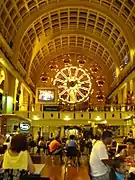
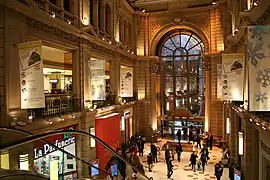
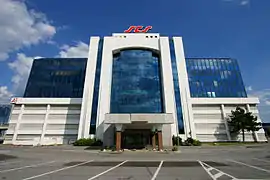
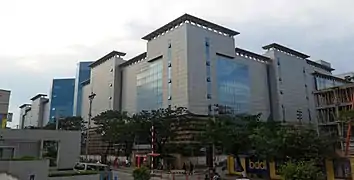
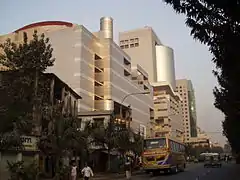
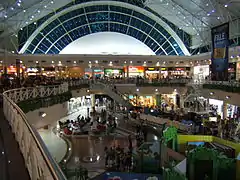
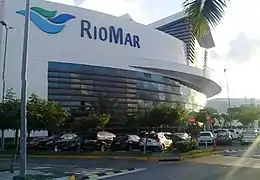
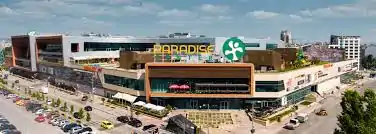
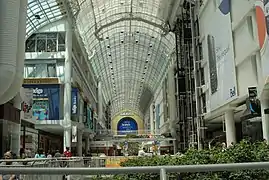
.jpg.webp)
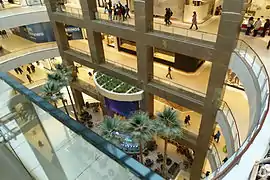
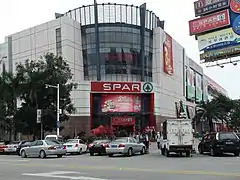
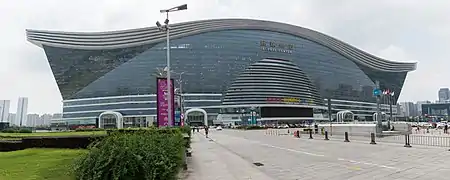


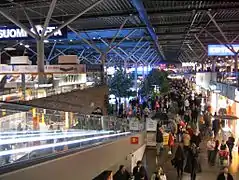




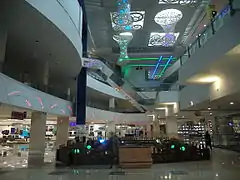



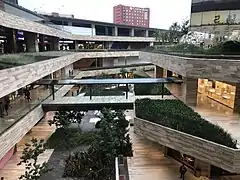
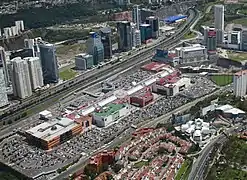 Centro Santa Fe
Centro Santa Fe
Mexico.jpg.webp) Morocco Mall
Morocco Mall
Morocco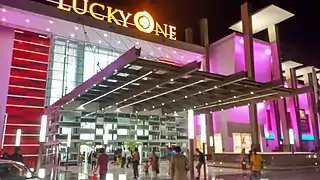
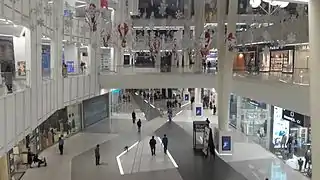 Emporium Mall
Emporium Mall
Pakistan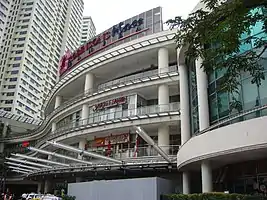 Robinsons Place Manila
Robinsons Place Manila
Philippines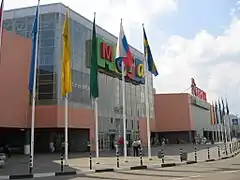
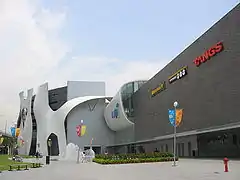

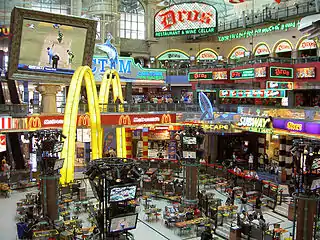

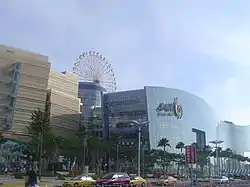 Dream Mall
Dream Mall
Taiwan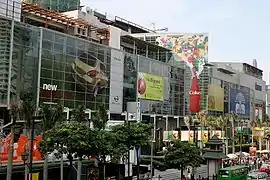
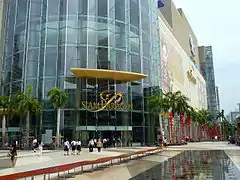
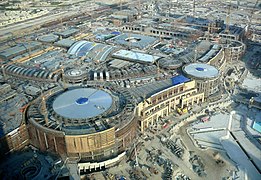
.jpg.webp) Mall of the Emirates
Mall of the Emirates
United Arab Emirates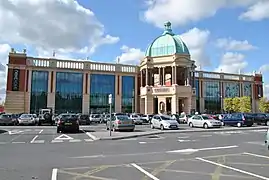 Trafford Centre
Trafford Centre
United Kingdom Liverpool One
Liverpool One
United Kingdom Destiny USA
Destiny USA
United States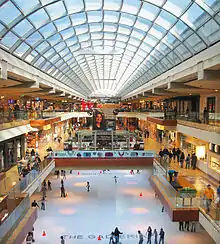 Houston Galleria
Houston Galleria
United States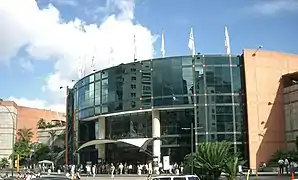 Sambil
Sambil
Venezuela
See also
- Alley
- Arcade
- Bazaar
- Lists of shopping malls
- Mall kiosk
- Pedestrian zone
- Retail#Types of retail outlets
- Shopping center
- All pages with titles containing List of largest shopping malls
- Lists of shopping malls by country
References
- Longstreth, Richard (1997). City Center to Regional Mall. MIT Press. p. 296–304. ISBN 0262122006.
"the essential framework for the regional mall", and other references in this page range and elsewhere to malls as a type of shopping center
- Rielly, Edward J. (2003). The 1960s. Westport, CT: Greenwood Press. p. 62. ISBN 0-313-31261-3. Retrieved 28 July 2020.
- Sarkar, John (June 18, 2020). "Most mall owners agree to retailers' rental terms". Times of India.
- "UAE's malls will need a full-scale repurposing". Gulf News. July 14, 2020.
- "Key Facts". Shopping Centre Council of Australia.
- "ICSC Shopping Center Definitions: Basic Configurations and Types" (PDF). International Council of Shopping Centers. 1999. Archived (PDF) from the original on March 8, 2014. Retrieved January 31, 2013.
- "US Shopping-Center Classification and Characteristics" (PDF). International Council of Shopping Centers. August 2015. Archived (PDF) from the original on March 3, 2016. Retrieved November 13, 2015.
- "Canada Shopping-Centre Classification and Typical Characteristics", ICSC, accessed July 15, 2020
- "Asia Shopping-Centre Classification and Typical Characteristics", ICSC, accessed July 15, 2020
- "Europe Shopping-Centre Classification and Typical Characteristics", ICSC
- "Passage du Caire". Insecula.com. Archived from the original on October 26, 2004. Retrieved November 9, 2012.
- "The Arcade, Providence RI". Brightridge.com. Archived from the original on August 27, 2009. Retrieved July 17, 2009.
- Icons of Cleveland: The Arcade. Cleveland Magazine, August 2009.
- Moore, Robbie. "The Death of the American Mall and the Rebirth of Public Space". The International. Archived from the original on March 13, 2013. Retrieved February 26, 2013.
- "Broadway's New Crenshaw Store to Open Today". Los Angeles Times. November 21, 1947.
- Raktis, Ted (September 9, 1961). "Shopping Mall Is Beautifier of Cities". Deseret News.
- "Ottawa Trying Out Shopping Mall Idea". Nanaimo Daily News. May 26, 1960.
- "Shopping Mall Scheme Gaining Favor in U.S." Calgary Herald. August 26, 1959. p. 1.
- Howard, Vicki (2008). The Routledge Companion to the History of Retailing. Taylor & Francis. ISBN 978-1-138-67508-7.
- "Appleton's Valley Fair Center". Mall Hall of Fame. November 1, 2006. Archived from the original on March 3, 2016. Retrieved October 21, 2015.
- "Basic facts – NCSC". NCSC. Nordic Council of Shopping Centers. Archived from the original on August 4, 2017. Retrieved May 29, 2017.
- Bathroom Reader's Institute (November 1, 2010). "The Mall: A History". Uncle John's Heavy Duty Bathroom Reader. Bathroom Reader's Press. pp. 99–101. ISBN 978-1-60710-183-3.
- Hardwick, M. Jeffrey (2015). Mall Maker: Victor Gruen, Architect of an American Dream. Philadelphia: University of Pennsylvania Press. p. 144. ISBN 9780812292992. Retrieved 14 July 2020.
- Newton, Matthew (2017). Shopping Mall. New York: Bloomsbury. p. 5. ISBN 9781501314827. Retrieved 14 July 2020.
- Gladwell, Malcolm (March 15, 2004). "The Terrazzo Jungle". The New Yorker. Archived from the original on July 9, 2014.
- Walker, Andrea K. (September 13, 2007). "Malls no more, centers looking to sell lifestyle". The Baltimore Sun. Retrieved August 29, 2020.
- Dery, Mark (November 11, 2009). "Essay – Dawn of the Dead Mall". The Design Observer Group. Archived from the original on July 24, 2011. Retrieved February 14, 2010.
- Bathroom Reader's Institute (November 1, 2010). "A History of the Shopping Mall, Part III". Uncle John's Heavy Duty Bathroom Reader. Bathroom Reader's Press. p. 401. ISBN 978-1-60710-183-3.
- Johnson, Caitlin A. (April 15, 2007). "For Billionaire There's Life After Jail". CBS News. Archived from the original on December 4, 2010. Retrieved December 29, 2009.
Alfred Taubman is a legend in retailing. For 40 years, he's been one of America's most successful developers of shopping centers. Taubman picked upscale areas and opened lavish shopping centers. He was among the first to offer fountains and feature prestigious anchor stores like Neiman Marcus. The Mall at Short Hills in New Jersey is one of the most profitable shopping centers in the country. Taubman is famous for his attention to detail. He's very proud of the terrazzo tiles at Short Hills. "The only point that the customer actually touches the shopping center is the floor," he said. "They've got traction as they're walking. Very important. Some of our competitors put in carpet. Carpet's the worst thing you can have because it creates friction."
- Peterson, Thane (April 30, 2007). "From Slammer Back To Glamour". Business Week. Archived from the original on April 25, 2010. Retrieved December 29, 2009.
Shopping mall magnate and onetime Sotheby's (BID) owner Alfred Taubman, 83, may be a convicted felon, but he's continuing to insist on his innocence in his just-out autobiography, Threshold Resistance: The Extraordinary Career of a Luxury Retailing Pioneer (Collins, $24.95). Writing on his business triumphs, Taubman is heavy on the boilerplate. But he gives a juicy personal account of the Sotheby's-Christie's price-fixing scandal that sent him to the slammer.
- Millar, Lisa (January 20, 2015). "Dead malls: Half of America's shopping centres predicted to close by 2030". Australian Broadcasting Corporation News. Archived from the original on October 24, 2015. Retrieved October 21, 2015.
- "The death of the US shopping mall". BBC News. November 4, 2014. Archived from the original on April 28, 2014.
- Schwartz, Nelson D. (January 3, 2015). "The Economics (and Nostalgia) of Dead Malls". The New York Times. Archived from the original on October 23, 2015. Retrieved October 21, 2015.
- Pleven, Liam (November 24, 2015). "Shrinking U.S. Shopping Malls Get Makeovers". Wall Street Journal. ISSN 0099-9660. Archived from the original on November 30, 2015. Retrieved November 30, 2015.
- "Online Sales Threat to American Malls". Financial Times. February 4, 2013. Archived from the original on July 6, 2015.
- Evans, Peter (February 20, 2013). "Malls' New Spin on Leisure". The Wall Street Journal. Archived from the original on August 15, 2017.
- "So Ouest lance l'offensive anti-e-shopping". Challenges. October 18, 2012.
- "Westfield launches new 'online mall' with 100,000 products". The Australian Financial Review. November 19, 2013. Archived from the original on September 14, 2015. Retrieved October 21, 2015.
- "Playbook to Safely Reopen Shopping Malls". Aislelabs. May 26, 2020. Retrieved June 2, 2020.
- "Shoppers Throng to Opening of Bergen Mall in Jersey". The New York Times. November 15, 1957. Archived from the original on January 26, 2012. Retrieved June 7, 2007.
Paramus, New Jersey, November 14, 1957. The $40,000,000 Bergen Mall regional shopping center opened here this morning.
- "10 Shopping Centers Scheduled For Allied Stores Within 3 Years". The New York Times. January 13, 1955. p. 37. Archived from the original on June 11, 2016.
- "The Super Centers". TIME. January 24, 1955. Archived from the original on December 15, 2008. Retrieved June 25, 2008.
The new centers, scheduled for opening by 1957, are designed to serve regions (i.e. customers within 40 minutes' driving time) rather than smaller suburban areas. The first to go into operation will be the $30 million Bergen Mall at Paramus, N.J., expected to be the biggest US shopping center. Puckett estimates that there are 1,588,000 customers within the 40-minute radius.
- "World's Largest Shopping Malls". Eastern Connecticut State University. January 2007. Archived from the original on March 29, 2008. Retrieved July 29, 2008.
- Chung, Danny (December 9, 2005). "Reach for the sky". The Standard. Archived from the original on January 2, 2008.
- "Discovering Shropshire's History: Shrewsbury Town Walls". Discovershropshire.org.uk. October 26, 1987. Archived from the original on July 20, 2011. Retrieved August 1, 2011.
- "UAE's malls will need a full-scale repurposing". Gulf News. July 14, 2020.
- Urban Geography: A Global Perspective Michael Pacione, (Routledge, Informa UK Ltd. 2001) ISBN 978-0-415-19195-1.
- Agovino, Theresa. "Investors Find Bargains at Europe's Outlet Malls". Wall Street Journal. ISSN 0099-9660. Archived from the original on December 3, 2015. Retrieved December 3, 2015.
- "ICnetwork.co.uk". Icbirmingham.icnetwork.co.uk. September 4, 2003. Archived from the original on February 11, 2009. Retrieved August 1, 2011.
- Kramer, Andrew E. (January 1, 2013). "Malls Blossom in Russia, With a Middle Class". The New York Times. Archived from the original on January 2, 2013. Retrieved January 2, 2013.
I feel like I’m in Disneyland
- This is Surrey (May 22, 2009). "Moka, Ashley Centre, Epsom". Surrey Mirror. Archived from the original on July 19, 2013. Retrieved October 21, 2015.
- O'Donahue, Tony (May 1, 2005). The Tale of a City: Re-Engineering the Urban Environment. Toronto: Dundurn Press Ltd. p. 43. ISBN 978-1550025569.
- Frieden, Bernard J.; Sagalyn, Lynne B. (1989). Downtown, Inc.: How America Rebuilds Cities. Cambridge, Massachusetts: MIT Press. p. 233. ISBN 978-0262560597. Retrieved October 21, 2015.
- Judd, Dennis R. (1991). "The Rise of the New Walled Cities". Maxine Goodman Levin College of Urban Affairs, Cleveland State University. Cite journal requires
|journal=(help) - Fich, Naima (5 May 2012). "Emporis: February 7, 2012 – List of the Top 10 World's Largest Shopping Mall" (PDF). Archived from the original (PDF) on 13 November 2013.
- Jevtic, Aleksandar (26 August 2015). "15 Biggest Malls in the World – Insider Monkey". InsiderMonkey.com. Archived from the original on 2 December 2015. Retrieved 4 December 2015.
- News, ABS-CBN (2016-12-19). "SM Prime opens 7th mall in China". ABS-CBN News. Retrieved 2020-11-27.
- "SM City Tianjin Opened In China". Malls.Com. 2016-12-19. Retrieved 2020-11-27.
- "WestGate mall opens to major crowds". Nikkei Inc. 30 August 2015. Archived from the original on 15 March 2018. Retrieved 14 March 2018.
- "Ikea building SE Asia presence". Bangkok Post. 16 March 2018. Retrieved 29 March 2019.
- "Central World".
- Pitsinee, Jitpleecheep (23 March 2016). "Iconsiam adds retail area for keen investors". Bangkok Post. Retrieved 11 November 2018.
- "Mall of American Fact Sheet 2016" (PDF). Mall of America. mallofamerica.com. Archived (PDF) from the original on 2016. Retrieved 23 December 2020.
- "Securities and Exchange Commission SRC Form 17-A" (PDF). SM Prime. 31 December 2018. Retrieved 4 October 2019.
- "SM Prime plans to continue developing SM North Edsa". BusinessMirror. Archived from the original on 20 August 2016. Retrieved 13 August 2016.
- "SM Prime opens the Mega Fashion; Transforms SM Megamall into the Philippines' Largest Mall". SM Investments Corporation. Archived from the original on 11 March 2017. Retrieved 13 August 2016.
- "Biggest mall in Vis-Min, SM Seaside City Cebu, opens November 27". Interaksyon. Archived from the original on 4 November 2016. Retrieved 13 August 2016.
SM said that the largest mall is SM Megamall at 474,000 square meters, followed by SM North EDSA at 470,000 square meters.
- "SM Megamall now PH's largest mall". Inquirer Business. Archived from the original on 3 February 2014. Retrieved 7 February 2014.
- "SM Prime opens the Mega Fashion; Transforms SM Megamall into the Philippines' Largest Mall". SM Investments Corporation. Archived from the original on 11 March 2017. Retrieved 13 August 2016.
- "Biggest mall in Vis-Min, SM Seaside City Cebu, opens November 27". Interaksyon. Archived from the original on 4 November 2016. Retrieved 13 August 2016.
SM said that the largest mall is SM Megamall at 474,000 square meters, followed by SM North EDSA at 470,000 square meters.
- "SM Megamall undergoing P1.5 B expansion". Rappler. Archived from the original on 27 September 2013. Retrieved 12 June 2013.
- ClickTheCity (2018-07-06). "SM MegaMall Cinema Movie Schedule – Mandaluyong City, Metro Manila @ ClickTheCity Movies". Clickthecity.com. Archived from the original on 3 September 2017. Retrieved 2018-07-21.
- "Biggest mall in Vis-Min, SM Seaside City Cebu, opens November 27". Interaksyon. Archived from the original on 4 November 2016. Retrieved 13 August 2016.
- "Shopaholics Rejoice: The 12 Biggest Malls in the World". Archived from the original on 29 August 2015. Retrieved 23 August 2015.
- "9 Largest Malls in the World". Largest.Org.
- "Setareh CO Officia Website". Archived from the original on 17 October 2018. Retrieved 28 July 2019.
- "12 LARGEST SHOPPING CENTERS WORLDWIDE". Archived from the original on 28 July 2019. Retrieved 28 July 2019.
- "Persian Gulf Complex Introduction". Archived from the original on 28 July 2019. Retrieved 28 July 2019.
- "Persian Gulf Complex Introduction From Official Site". Archived from the original on 27 August 2018. Retrieved 28 July 2019.
- "Persian Gulf Complex Introduction".
- "Persian Gulf Complex Introduction From Official Site".
- "Central Festival Phuket – new building construction", Phuket9
- "Central Phuket Festival", Central Pattana site
- "B20bn Central Phuket to open Sept 10", The Phuket News, 15 August 2018
- "Siam Paragon". Bangkok.com. Archived from the original on 4 July 2014. Retrieved 28 July 2014.
- "Filinvest Land, Incorporated 2017 Annual Report" (PDF). filinvestland.com. Archived from the original (PDF) on 24 October 2018. Retrieved 31 July 2018.
- "Archived copy". Archived from the original on 1 September 2016. Retrieved 5 September 2016.CS1 maint: archived copy as title (link)
- "Asia's 'biggest' mall in Dhaka". The Daily Star. Dhaka. 10 April 2008. Retrieved 26 September 2020.
- "5th Floor Is Open Now". Jamuna Future Park. Archived from the original on 20 September 2013.
- "Mal Taman Anggrek Cetak Rekor "The World Largest LED Illuminated Facade"". Archived from the original on 2 November 2016. Retrieved 5 January 2017.
- "World's Largest Shopping Malls". web.archive.org. 2012-03-05. Retrieved 2020-11-27.
- "Dubai Mall". Archived from the original on 7 March 2008. Retrieved 14 January 2008.
- "Zawya – The Dubai Mall". Archived from the original on 8 January 2009. Retrieved 6 December 2008.
- "Sheikh Mohammed bin Rashid al-Maktoum formally opens the Dubai Mall". Archived from the original on 15 May 2009. Retrieved 12 May 2009.
- Ijaz, Zaid (February 1, 2018). "Lucky One Mall". Pakpedia. Retrieved September 28, 2020.
- Khan, Haris (June 4, 2017). "21 Amazing Photos and Facts About Lucky One Mall Karachi – The Biggest Shopping Mall in Pakistan". Paki Holic. Retrieved January 4, 2020.
- "Gandaria City Mall in Jakarta – Shopping in Jakarta, Indonesia – Justgola". Justgola. Archived from the original on 21 July 2018. Retrieved 2017-07-15.
- "Trivia: CDO Did You Know?". CDOpedia. 7 August 2012. Archived from the original on 21 July 2018.
- "Limketkai Mall – biggest in Mindanao". CDO Dev. 6 November 2012. Archived from the original on 21 July 2018.
- "Berjaya Times Square info page". Archived from the original on 7 February 2008. Retrieved 14 February 2008.
- "Iran Mall's 1st Phase Takes Off". Financial Tribune. 2018-04-30. Archived from the original on 2 April 2019. Retrieved 2019-02-17.
- Financial Tribute – Iran Mall
- Holman, Jordyn (7 January 2020). "American Dream Mall Bucks Retail Nightmare, Nears 90% Lease Rate". Bloomberg. Retrieved 23 June 2020.
- "PTI Architects". www.pti-architects.com. Archived from the original on 16 August 2017. Retrieved 2017-07-15.
- "Tenant List". MAl Artha Gading. Archived from the original on 24 March 2019. Retrieved 24 March 2019.
- "Shop List". Mall of Arabia. Archived from the original on 24 March 2019. Retrieved 24 March 2019.
- "International Council of Shopping Centers". ICSC. Archived from the original on 26 July 2011. Retrieved 14 February 2012.
- "International Council of Shopping Centers: King of Prussia Mall". Archived from the original on 21 October 2007. Retrieved 14 February 2008. The Mall of America once again surpassed it when it built an addition to the mall that included a J.W. Marriot Hotel
- Pakuwon Indonesia. "Properties". Pakuwon.com. Archived from the original on 22 July 2017. Retrieved 2018-07-21.
- Samrashabir (April 24, 2017). "Emporium Mall Lahore". Pakpedia. Retrieved September 28, 2020.
- "ICSC DMM Display". Icsc.org. Archived from the original on 11 October 2012. Retrieved 14 February 2012.
- Roxburgh, Helen (23 March 2017). "Welcome to Yiwu: China's testing ground for a multicultural city". The Guardian. Archived from the original on 23 March 2017. Retrieved 23 March 2017.
Further reading
- Hardwick, M. Jeffrey. Mall Maker: Victor Gruen, Architect of an American Dream (2004) excerpt and text search
- Howard, Vicki. From Main Street to Mall: The Rise and Fall of the American Department Store (2015)
- Ngo-Viet, Nam-Son. Google Docs 2002. The Integration of the Suburban Shopping Center with its Surroundings: Redmond Town Center (PhD Dissertation) University of Washington.
- Scharoun, Lisa. America at the Mall: The Cultural Role of a Retail Utopia (Jefferson, NC: McFarland, 2012)
- Lange, Alexandra (February 15, 2018). "Malls and the future of American retail: In a post-mall era, why are starchitects building more retail?". Curbed. Retrieved March 3, 2018.
External links
| Wikimedia Commons has media related to Shopping malls. |